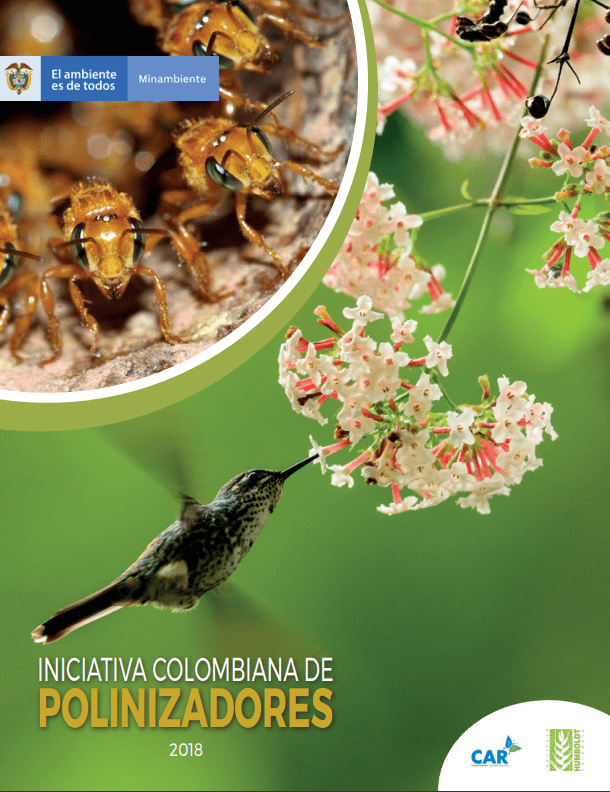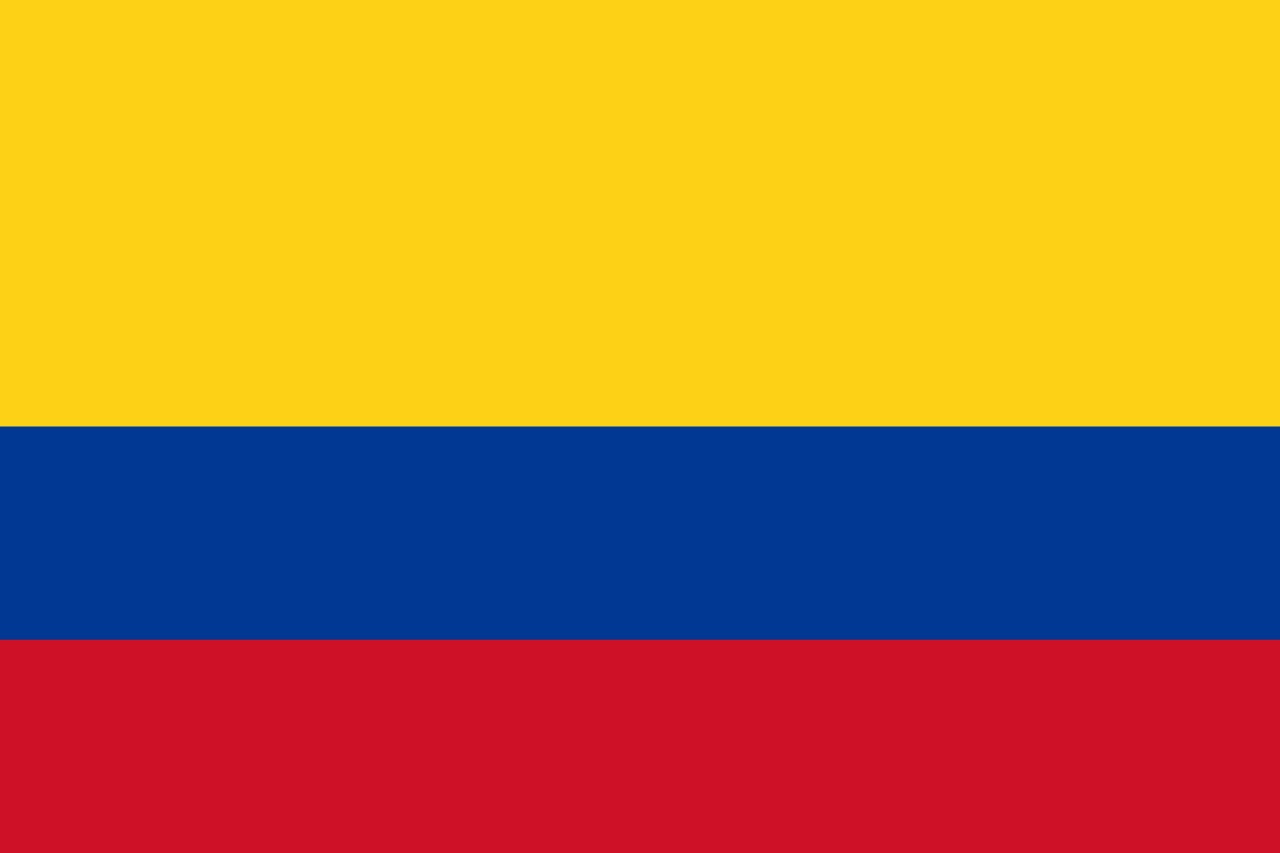Colombia
Colombia joined Promote Pollinators in 2018, during the sixth IPBES conference in Medellin, Colombia. The declaration was signed on Wednesday the 21st of March, during a sign-up event organised by the Promote Pollinators secretariat.
Why did Colombia decide to join the coalition?
Colombia joined to Promote of Pollinators because it recognizes pollination like a strategic ecosystem service that plays a vital role in the conservation of biological diversity, the maintenance of function and structure of ecosystems, food production and the global economy.
This recognition is in accordance to the National Policy for Integral Management of Biodiversity and their Ecosystem Services. This Policy represents the process through which the actions are planned, monitored and executed for conservation of the biological diversity and their ecosystem services, in a defined social and territorial scenario, and in different states of conservation, with the purpose of maximizing the human wellbeing through the maintenance of the resilience of the socio-ecological systems to the cross-border, national, regional and local scales.
The situation in Colombia
Within the framework of the Intergovernmental Platform on Biodiversity and Ecosystem Services, one of the goals and planned outcomes in the working program of the Platform (2014-2018) is the fulfillment of a thematic assessment, by fast way, of pollination, pollinators and food production. This task gathered experts around the world (including Colombia) in order to collect the existing information about the diversity and state of the pollinators, the dynamic of the pollination, the factors that generate changes in the service of pollination, the effects that cause decrease and deficit of pollinators in the human wellbeing, and answers for dealing these changes, as economic and non-economic value of the pollination.
The Colombian Pollinators Initiative, Chapter Bees, has registered an accelerated decline of wild pollination service in a global level in the last years. Scientists, politicians and general public have shown their concern on this topic (Aizen y Harder, 2009). Even global instances like IPBES (Intergovernmental Platform on Biodiversity and Ecosystem Services) published an urgent assessment on February 2016. The government approved the final report on February 26, 2016, which was prepared by a team of 77 experts from around the world. The final Inform and the executive summary for the policy makers at the national level were presented in the plenary Session of IPBES, and they were assessed and approved by represents from the 124 countries that are part of the Intergovernmental Platform on Biodiversity and Ecosystem Services (IPBES) in Kuala Lumpur (Malaysia).
The pollinators more threatened by different drivers and more documented have been the European bee Apis Mellifera, distributed today in all continents, except Antartic, and the bumblebee from Bombus genre, that have been introduced more of 11 countries in South and North America, Australia and Asia (Stout y Morales, 2009). Those drivers include the loss and fragmentation of natural habitats, the disturbs caused by the increasing in the use of pesticides, herbicides, monocultures that sacrificed the floral diversity, pathogen spread, virus and parasites by productive and commercial practices, the introduction of pollinators and plants no-native that generate unfavourable competition, and finally, the climate change (Lautenbach et al., 2012).
Colombian Pollinators Initiative
Since Colombia joined Promote Pollinators in March 2018, the country took major steps in protecting pollinators and their habitats. A year later, in May 2019, Colombia concretized their active participation with a newly developed national strategy, in which they incorporated a roadmap with priorities. The newly developed strategy is the result of a collaboration with a large group of stakeholders and many inspiring initiatives. The strategy consists of five different axis, in which specific goals for the preservation of pollinating species on a national scale are discussed:

Axis I: Knowledge, evaluation and monitoring.
Colombia, listed as the second country in diversity of plants, requires to generate knowledge in order to correctly identify, describe and characterize pollinators and pollination. This will prove useful for effective decision-making processes on conservation, sustainable use and evaluation of the situation of pollinator decline that is reported globally. Therefore, Colombia formulates as a goal: “to generate knowledge related to the identification, distribution, biology of pollinating species, the pollination ecosystem service and the risk of extinction of pollinators, prioritizing native species”
Axis II: Evaluation of the pollination ecosystem service.
A reliable evaluation of the pollination service consists of an economic (monetary) and non-economic (qualitative and quantitative) evaluation of the benefits for the health of ecosystems and human well-being. Therefore, Colombia formulates as a goal: “to characterize economically and non-economically the ecosystem service of pollination in Colombia”.
Axis III: Promotion of healthy habitats for pollinators.
Pollinators and the pollination service are being affected by the five direct drivers of transformation and loss of biodiversity and their ecosystem services: the transformation and loss of ecosystems and natural habitats, overexploitation, biological invasions, pollution and climate change, to which reference is made in the National Policy for the Integral Management of Biodiversity and its Ecosystem Services. Therefore, Colombia formulates as a goal: “to maintain, secure and restore habitats for pollinators through good practices and the promotion of the conservation of natural ecosystems and diversification of agroecosystems, urban and industrial areas”.
Axis IV: Capacity building and participation.
It is essential that the different actors interacting directly or indirectly have the knowledge and skills for an adequate management of this ecosystem service. Therefore, Colombia formulates as a goal: “to formulate, strengthen and implement processes aimed at raising awareness, ownership and training of society on the importance of pollinators and pollination as an ecosystem service”.
Axis V: Mainstreaming in policy, legislation and decision making.
The inclusion of pollination service management in decision-making is one of the main challenges and final objectives of the Colombian Pollinators Initiative because it is fundamental for the maintenance and improvement of the quality of life of the Colombian population, for which efforts are required for the mobilization of national and international resources. Therefore, Colombia formulates as a goal: “to incorporate the sustainable management of pollinators and the pollination service into the public policy instruments and decision-making scenarios”.
Current status
According to the Red Book on Terrestrial Invertebrates from Colombia, the bees are one of the important groups of insects by their roll like pollinators of wild and domesticated flora. They are grouped in 7 families from which 5 families are located in Colombia. They depict big diversity in size, nesting habits, behavior and sociability levels. This book includes the next endangered species (see table):
With relation to the actual state of the pollinators, there are not direct evidences of disappearance of the pollinators in Colombia. One of the problems is that, for many of those species, mainly for insects, there are not complete inventories in the country. For that reason, until now, it is not possible to know what has been lost. Moreover, the direct evidence studies about the fluctuation of pollinator populations and their possible decline or actual deficit are faced to various inherent difficulties to the pollinators themselves.
| Nombre común (common name) | Nombre científico (scientific name) | Grado de Amenaza (threat) |
| Abeja real | Melipona eburnea | VU |
| Abeja rabipintada | Melipona favosa | VU |
| Abejita amazónica | Aglae caerulea | VU |
| Abejita estacional amazónica | Eufriesea au ripes | EN |
| Abejita de la Sierra Nevada | Eufriesea chrys opyga | EN |
| Abejita verde de la Macarena | Eufriesea dressleri | CR |
| Abejita del Anchicayá | Eufriesea lucida | EN |
| Abejita del Pacífico | Eufriesea lucifera | EN |
| Abeja esmeralda | Exaerete dentata | CR |
| Abejita verde del Llano | Exaerete frontalis | CR |
2007. Libro Rojo de los Invertebrados Terrestres de Colombia / eds. Amat-G. G., M. Gonzalo Andrade-C. y Eduardo C. Amat G. – Bogotá: Instituto de Ciencias Naturales- Universidad Nacional de Colombia, Conservación Internacional Colombia, Instituto Alexander von Humboldt, Ministerio de Ambiente, Vivienda y Desarrollo Territorial. 216p.
As far as the bees are concerned, we can mention three important features about them: Firstly, the communities of wild bees exhibit substantial variation in space and time, even in unchanged ecosystems. Secondly, the communities of wild bees in the local level and the apoidean bees in the regional level are very diversities with a high index of weird species, therefore, they are susceptible to being underestimated or to suffering changes in the assembly of species, in addition of being subject of replacement events or recolonization of seemingly missing species. Thirdly, other difficulty is related with taxonomy. It is not easy to say what it is being lost or decreased, being imperative to lead the efforts around training the specialized professionals in bee taxonomy and the decided support to the entomological collects (Ospina-Torres y Nates-Parra, 2017).
Some national studies refer to decreasing of wild bees in some regions in Colombia. Twenty years ago, in Cundinamarca State, specifically Arbelàez Town and Paime Town, located in the eastern mountain range, it was easier than now to find the nests of at least 5 species of Melipona: M. eburnea, M. fuliginosa, M. compressipes, M. grandis y M. melanopleura (Nates-Parra, 2005). Now it is barely found those nests.
The existing risks for stopping the nesting of various groups of pollinators can be produced by the bad habits in agrochemical application, climate change, intensive agriculture, pathogens, loss of habitats, loss of food resources, and others.
What is necessary in order to successfully create and implement a national strategy?
- Doing inventories on pollinators
- Analysing the risks of the extintion of pollinators and the state of their habitats
As to bats, there are not a lot of information about their role like pollinators, and a lot less about their loss and their decreasing populations. Although, a study shows the wealth and diversity of this group in a specific place in Colombia, Villavicencio, at the same time, it points out their population is threatened by the human activity, and particularly, by disappearance of more than 80% the native forest and the reduction of the available habitat. Accordingly, this study suggests the disappearance of various bat species, at least in the local level (Sánchez 2017).
Do you want to know more about Colombia’s efforts? Or do you want to get in touch?
For more information you may reach out to Guiomar Nates Parra through e-mail:

